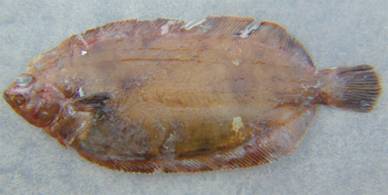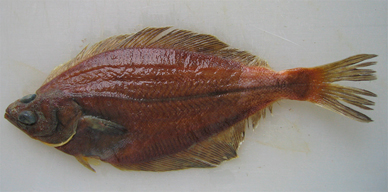Reversals in two dextral flounder species, Microstomus achne and Cleisthenes pinetorum (Pleuronectida; Teleostei), from Japan
Abstract
Reversals are described in Microstomus achne (three specimens) and Cleisthenes pinetorum (one specimen) collected from the Pacific coast of northern Japan, being the first published records of reversals in these genera.
The teleostean order Pleuronectiformes (flatfishes) is unique amongst vertebrates in exhibiting striking bilateral asymmetry, having both eyes anatomically on one side of the body (Hubbs & Hubbs, 1945). In most species, the eye positions are almost always fixed to one side, i.e. both eyes on the right (dextral) side (e.g. Pleuronectidae) or on the left (sinistral) side (e.g. Paralichthyidae and Bothidae). Various abnormalities associated with body asymmetry have been recorded in many flatfish species (Norman, 1934; Hubbs & Hubbs, 1945; Dawson, 1962). Reversal, an unusual rotation of the eyes, is extremely rare in the dextral flounder family Pleuronectidae and regarded as an abnormality in most species, except for Platichthys stellatus (Pallas) and Platichthys flesus (L.) in which the phenomenon commonly occurs (Hubbs & Kuronuma, 1942; Hubbs & Hubbs, 1945; Bruno & Fraser, 1988).
In the pleuronectid genus Microstomus, xanthochroism has been reported in Microstomus achne (Jordan & Starks) from Japan (Amaoka, 1994; Maruyama, 1976), and absence of the dorsal, caudal and anal fin rays in Microstomus pacificus (Lockington) from Californian waters (McCormick & Baldwin, 1952). In the pleuronectid genus Cleisthenes, albinism, ambicolouration and shortening of the posterior vertebrae have been reported in Cleisthenes pinetorum Jordan & Starks (Nishimura & Ogawa, 1963; Imaoka & Nishimura, 1964). There have been no records to date, however, of eye reversal in either genus.
In the present study, reversals are reported in three specimens of M. achne and one of C. pinetorum collected in 2004 from coastal waters off Iwate Prefecture, Pacific coast of northern Japan. Brief morphological descriptions are included here. The specimens are deposited in the collections of the Marine Zoological Laboratory, Hokkaido University (HUMZ) and Iwate Fisheries Technology Centre (IFES). Microstomus achne: HUMZ 189776, 272·1 mm standard length (LS) female, Kamaishi Fish Market, January 2004; HUMZ 189777, 296·7 mm LS, female, 39°15′ N; 142°00′ E, off Kamaishi, Iwate Prefecture, 100 m depth, gillnet, January 2004; IFES 2004–001, 274·9 mm LS, female, 39°15′ N; 142°00′ E, off Kamaishi, Iwate Prefecture, 100 m depth, gillnet, January 2004. Cleisthenes pinetorum: IFES 2004–002, 212·1 mm LS, female, 39°15′ N; 142°00′ E, off Kamaishi, Iwate Prefecture, 100 m depth, gillnet, January 2004. Representative morphometric and meristic characteristics are given in Table I.
| M. achne | C. pinetorum | |||
|---|---|---|---|---|
| HUMZ 189776 female | HUMZ 189777 female | IFES 2004Š002 female | IFES 2004Š002 female | |
| *Measurements | ||||
| L S (mm) | 272·1 | 296·7 | 274·9 | 212·1 |
| Body depth | 13·3 | 12·5 | 13·8 | 36·8 |
| Head length | 7·8 | 7·3 | 8·0 | 26·8 |
| Upper jaw length | ||||
| Ocular side | 1·8 | 1·6 | 2·0 | 9·3 |
| Blind side | 1·9 | 1·8 | 2·1 | 10·3 |
| Eye diameter | ||||
| Upper | 1·7 | 1·6 | 1·7 | 5·8 |
| Lower | 1·7 | 1·6 | 1·7 | 5·9 |
| Interorbital width | 1·6 | 1·6 | 1·1 | 2·1 |
| Pectoral fin length | ||||
| Ocular side | 4·9 | 5·0 | 4·8 | 13·5 |
| Blind side | 3·5 | 3·8 | 3·2 | 10·5 |
| Pelvic fin length | ||||
| Ocular side | 2·2 | 1·8 | 2·0 | 9·6 |
| Blind side | 1·9 | 2·0 | 2·1 | 9·7 |
| Caudal peduncle length | 6·9 | 6·9 | 6·9 | 22·8 |
| Caudal peduncle length | 9·6 | 10·2 | 10·3 | 19·0 |
| Meristics | ||||
| Number of fin rays | ||||
| Dorsal fin | 92 | 89 | 93 | 71 |
| Pectoral fin | 8 | 8 | 9 | 11 |
| Anal fin | 72 | 70 | 75 | 56 |
| Pored scales in lateral line | 109 | 120 | 109 | 83 |
- * L S, standard length expressed in mm; all other measurements as % LS.
Identifications were based on diagnostic features of the two species noted by Norman (1934), Amaoka (1994) and Nakabo (2000). Microstomus achne (272·1–296·7 mm LS) are described as follows (Fig. 1 and Table I[link]): body elongate, oval, covered with considerable mucus; eyes small, upper one completely rotated onto left (ocular) side of head; nostrils asymmetrical, left one anterior to lower eye and right one (on blind side) immediately anteroventral to dorsal fin origin; mouth very small, a row of incisory teeth forming a continuous cutting edge restricted to blind side, thick lips; gill opening small; dorsal end of gill opening anterior to pectoral fin base on both sides; pectoral fin small, weakly asymmetrical; dorsal fin origin above centre of upper eye; caudal fin profile rounded; body uniformly light brown on ocular side, milky-white with small indistinct dark blotches on posterior region of body, and dark margins on pectoral, dorsal and caudal fins on blind side. Intestinal projection into posterior extension of abdominal cavity on ocular side; liver unevenly distributed on blind side.

A reversal specimen of Microstomus achne, HUMZ 189776, 272·1 mm standard length.
Cleisthenes pinetorum (212·1 mm LS) is described as follows (Fig. 2 and Table I[link]): body rhombic; lateral line nearly straight above pectoral fin; eyes large, scaleless, upper one rotated on dorsal crest of head; nostrils asymmetrical, left one anterodorsal to lower eye and right one (on blind side) anteroventral to upper eye; mouth large, posterior margin of maxilla below centre of lower eye; teeth small, conical, developed on both sides; gill opening large; dorsal end of gill opening well dorsal to pectoral fin base on both sides; pectoral fin large, weakly asymmetrical, third to eighth fin rays branched; dorsal fin origin immediately behind upper eye; caudal fin profile pointed at midpoint; body uniformly dark brown on ocular side, milky-white on blind side. Intestinal projection and liver unevenly distributed on ocular and blind sides, respectively.

A reversal specimen of Cleisthenes pinetorum, IFES 2004–002, 212·1 mm standard length.
In all of the specimens, almost complete mirror imaging reversal (situs inversus) was presented. No other abnormalities, such as a hook-shaped dorsal fin origin or ambicolouration (Gudger, 1934; Norman, 1934; Hubbs & Hubbs, 1945; Dawson, 1962; Gartner, 1986) were apparent. While some abnormalities, including ambicolouration and incomplete eye rotation with a hook-shaped dorsal fin origin, are likely to be related to environmental factors (early life habitat or conditions during rearing: Gartner, 1986; Aritaki et al., 1996; Aritaki & Seikai, 2004), Hubbs & Kuronuma (1942) considered reversal in flatfishes to be a genetically-based phenomenon.
In some pleuronectid species, e.g.Pleuronectes herzensteini (Jordan & Snyder), Pleuronectes yokohamae (Günther), Pleuronichthys cornutus (Temminck & Schlegel) and Verasper variegatus (Temminck & Schlegel), reversals have been frequently observed in hatchery-reared individuals, although rarely seen in wild fishes (Hubbs & Hubbs, 1945; Kamei, 1983; Kitajima et al., 1987; Mutsutani, 1988; Saotome & Aritaki, 1988; M. Aritaki, unpubl. data). Duncker (1900) showed mortality rates in reversed fish to be significantly higher than in normal dextral forms in P. fresus collected from Europe. Gudger (1935) had earlier suggested that the infrequent observation of reversals in wild fishes might be due to the increased mortality rate of such individuals during metamorphosis, relative to the normal form. No compelling evidence, however, has been presented to explain why the mortality rate in reversed pleuronectid fishes is higher than that in normal fishes (Hubbs & Hubbs, 1945; Bruno & Fraser, 1988).
Hatchery-rearing techniques developed for M. achne have resulted in the release of up to 28 000 juveniles in northern Japan (Tominaga, 1992; M. Aritaki, unpubl. data). Reversals have been frequently noted in hatchery-reared individuals of M. achne, as in other pleuronectids noted above (M. Aritaki, unpubl. data). Because no hatchery-reared individuals of M. achne have been released since 1995, however, all the reversed specimens examined here are thought to be wild fishes.
Acknowledgments
I sincerely thank M. Aritaki, Miyako Station, National Centre for Stock Enhancement, Fisheries Research Agency, who gave me helpful suggestions on reversal in flatfishes, and G. S. Hardy and two anonymous reviewers for their critical reading and helpful comments on the manuscript. I am grateful to H. Imamura, Hokkaido University Museum, for providing HUMZ labels and references, and to S. Sasaki, a fisherman belonging to the Kamaishi-wan Fisheries Cooperative, and all staff of Kamaishi Fish Market who collected and donated the materials examined.




